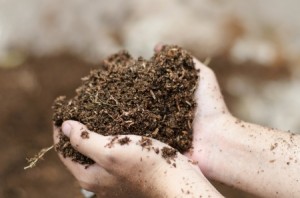
Mixing organic matter back in to the soil
will improve soil structure and tree health.
The trees in your landscape are not growing in ideal conditions. When new properties are developed, often the topsoil is removed. What remains is low in organic matter and often deficient in essential elements for tree growth. Furthermore, the repeated removal of leaf litter and grass clippings interrupts the natural recycling of nutrients back into the urban soil.
The soils of the eastern deciduous forest were well-aerated and naturally mulched by recycled leaf litter. Healthy forest trees flourished, even when growing in soils with moderate nitrogen availability. No synthetic fertilizers were needed.
Our urban soils are often nitrogen deficient, but we only need to correct the deficiency. Adding too much nitrogen is expensive, wasteful, and pollutes our local waterways. We need to fertilize trees properly by first understanding the impact on overall tree health. As arborists, we are not solely interested in promoting fast tree growth, we are interested in optimal tree health. This requires proper nutrient management.
Trees Are Autotrophs
We cannot feed a tree. Trees are autotrophs. They use light, water, atmospheric carbon and other essential elements to create energy-rich carbohydrate molecules. When we fertilize trees we are adding essential elements to the soil. We are not feeding the tree.
Nutrients for Trees
Research has found sixteen chemical elements that are essential for tree growth (there may be as many as nineteen). Without access to all of these essential elements a tree will not survive.
Carbon and oxygen can be obtained by splitting carbon dioxide molecules from the atmosphere. Oxygen and hydrogen can be obtained by splitting water molecules absorbed from the soil. The remaining thirteen elements are obtained from the soil. Trees need relatively large amounts of nitrogen, phosphorous and potassium. In our local soils, phosphorous and potassium are usually found in sufficient quantities, but additional nitrogen is sometimes needed to improve tree health.
Testing and Analysis
We utilize laboratory soil testing to reveal pH, soil structure, nutrient levels, organic matter and other soil properties. Additionally we utilize foliar testing to reveal which nutrients are actually present in the tree. Additionally, leaf size, leaf color, and twig growth rate can be observed by an experienced and skilled arborist to assess tree health and nutritional needs.
Prescribing Dosage
We need to know the reasons why a deficiency exists before we attempt to alleviate it. Environmental factors could be preventing the uptake of nutrients or the nutrients may not be present in sufficient quantity. We can only prescribe a remedy when we fully understand the underlying cause of the problem.
If we want improved tree health we need to understand that dosage is important. While nutrient deficiencies can cause problems for trees, it’s vital to recognize that unnecessary fertilization can be expensive, can cause root damage, and can easily contaminate ground water and pollute the Chesapeake Bay and other local waterways. Understanding nutrient management and the complex interrelationships between trees, soil, water, and essential elements is critical for healthy trees and a healthy environment.
